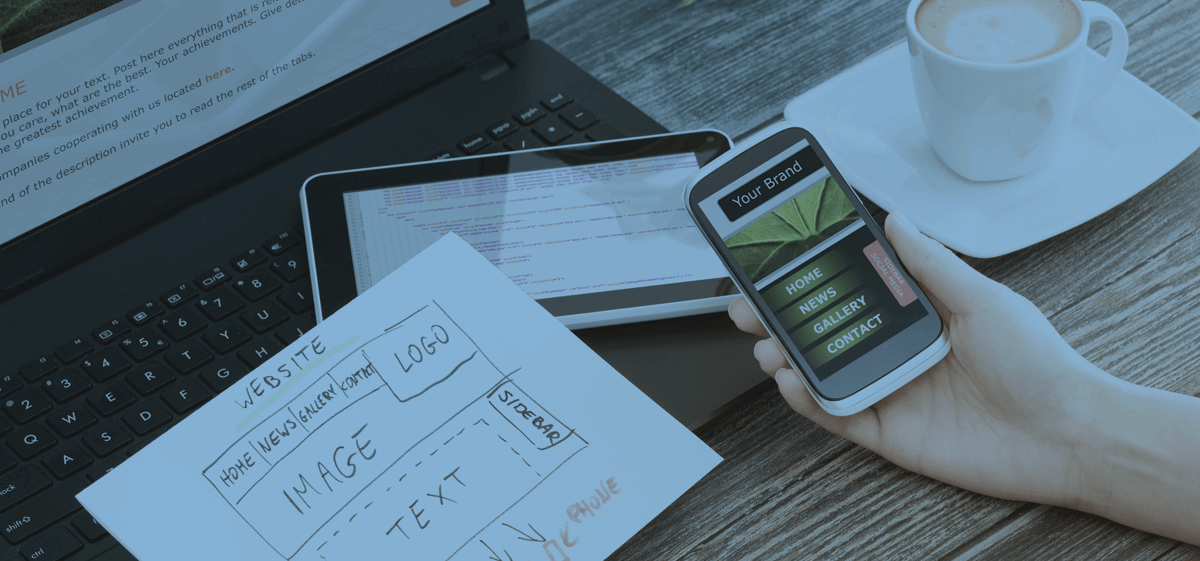Get your free consultation today!
Share with your Colleagues
Categories
ROI Calculator
Moonstone Interactive is the only San Francisco Bay Area web design firm and Internet Marketing expert that offers a free online ROI Calculator
Author: Steve Herz

Table of Contents
- What is a Headless CMS?
- Top 9 Benefits of Using a Headless CMS
- Optimized Omnichannel Experience
- Improved Performance and Faster Load Times
- Wider Market Reach
- Search Engine Optimization
- Content Internalization and Localization
- Better Developer Flexibility and Productivity
- Scalability and Future-Proofing
- More accessible Updates, Security, and Maintenance
- Simpler Scalability
- Say Goodbye to CMS Headaches With Moonstone Interactive
- FAQs About Headless CMS Platforms
Remember when traditional CMS platforms were the go-to for building and managing websites? They were the norm, and they worked just fine for a while.
Everything you needed—content creation, design, and site management—was bundled into one package.
But as the digital landscape evolved, so did the challenges.
With the rise of mobile apps, smart devices, and omnichannel marketing, the limitations of traditional CMS have become more apparent. Slow load times, limited flexibility, and the frustration of trying to fit new technology into an outdated system are all signs that it might be time to move on.
Now more than ever, it's time to move onto a CMS platform that offers the speed, scalability, and adaptability you need to stay ahead.
Still on the fence? In this guide, we'll highlight nine of the most significant benefits of adopting a CMS architecture for your brand.
What is a Headless CMS?
Imagine you're working on a website, and the site's content and design come from one place. That's how a traditional CMS (Content Management System) works. It's all bundled together, like a one-stop shop for building your site.
But with a headless CMS, it's like someone took the "head" (which is the design and layout part presented on HTML pages) and separated it from the "body" (where you store and manage content).
So, with a headless CMS, you manage all your content in one place, but you're not limited to a specific design or website. You can send that content anywhere—like to a website, a mobile app, or even a smartwatch—through an API (which is just a fancy way of saying it's a tool that lets different systems talk to each other).
Headless CMS vs. Traditional CMS Architecture
With a traditional CMS, everything's bundled together—the content, the design, the backend—all in one neat package. It's convenient if you're running a simple blog or a basic website because everything you need is right there. But here's where the pain kicks in.
First off, traditional CMS can be pretty limiting. You're stuck with the templates and themes they offer, which might not give you the look or functionality you want. Want to create something unique? You might find yourself wrestling with the CMS's built-in features, trying to bend them to your will—which can get frustrating.
Then there's the issue of performance. The site can get bogged down since the front end (what users see) and backend (where you manage content) are tightly linked. This dependency can lead to slower load times, especially if your site starts growing or you're trying to serve content on different devices.
Now, a headless CMS comes in to fix these pain points. It separates content management from the front end, giving you way more freedom to design and deliver content however you want. You're not stuck with just one design or platform—you can send your content anywhere without being held back by the limitations of a traditional CMS.

Other Types of CMS
Decoupled and hybrid CMSs offer a nice balance between traditional and headless systems, each with perks.
A decoupled CMS architecture separates the backend from the front end, similar to a headless CMS. But unlike a purely headless system, it also includes a built-in front end that you can use.
This architecture gives you flexibility—you can use the pre-designed front end when it's convenient but still have the option to deliver content through APIs to other platforms.
A hybrid CMS goes further by combining the best of both worlds. It offers the flexibility of a headless CMS, letting you deliver content anywhere via APIs. It also provides easy-to-use templates and tools like a traditional CMS.
You can stick with familiar tools when they suit you, but tap into the power of a headless setup when you need more control.
Top 9 Benefits of Using a Headless CMS
We've already mentioned a few benefits of a headless CMS architecture. Still, we must dive into all the main advantages to clarify why it's a worthwhile investment. Here are some of the most significant benefits of headless architecture:
1. Optimized Omnichannel Experience
A headless CMS is like having a control center for all your content. You can manage multiple channels, such as websites, mobile apps, and social media platforms, from one place and publish content wherever your audience is. The goal? To keep everything consistent across the board.
Why It's Important
These days, people interact with your brand across multiple platforms. They might start on your website, switch to your app, or catch up with you on social media. Your content can feel disjointed and leave a poor impression if inconsistent.
So, having a unified experience everywhere is essential to keeping your brand strong and your audience happy.
How a Headless CMS Can Help
A headless CMS makes delivering a consistent experience across all channels easy. You update your content once, and it automatically appears wherever you need it—on your website, app, and beyond. There is no need to tweak each platform manually.
Plus, because it uses APIs, you can easily integrate with new technologies as they come along. It gives you a future-proof content strategy that prepares you for whatever's next.
2. Improved Performance and Faster Load Times
According to Forbes, if it takes more than three seconds to load, 40% of users will leave a website. A headless CMS helps avoid this problem by separating the data and logic layer from your presentation layer, which allows you to streamline your code and deliver content faster.
Why It's Important
We've all been there—waiting for a website to load and getting frustrated when it takes too long. Slow load times drive people away from your site and hurt your search engine rankings.
How a Headless CMS Can Help
A headless CMS improves performance by allowing you to optimize your front end without being tied down by the back end. Since the two are separate, you can create a leaner, faster front end that loads quickly.
The improved performance makes for a better user experience. It also boosts search engine rankings because speed is a significant factor in SEO.

3. Wider Market Reach
Are you looking to get your content in front of more people? A headless CMS makes it a breeze. You can quickly push your content to different channels without recreating it for each platform.
Why It's Important
Your audience isn't just hanging out on your website; they're everywhere—on their phones, social media, and all devices.
To connect with them, you need to be where they are. Expanding your reach across multiple platforms ensures that your content gets seen by as many people as possible.
How a Headless CMS Can Help
A headless CMS helps you reach a wider audience by letting you manage and distribute your content from one place.
You create your content once, ready to go wherever you need it—your website, app, or any other platform. There is no need to start from scratch for each channel, saving time and effort while broadening your content's reach.
4. Search Engine Optimization
A headless CMS can help improve your SEO significantly. Because it lets your site load faster, gives you more control in building it, and ranks higher in search results.
Why It's Important
Here's a simple truth—getting noticed online isn't easy. The better your SEO, the more likely people will find your site when searching for something. But if your site's slow or poorly organized, search engines won't rank you as high, meaning fewer visitors.
How a Headless CMS Can Help
With a headless CMS, you can fine-tune your site's speed and structure. Faster load times make search engines happy, which helps your site rank higher.
Plus, you've got more flexibility to adjust metadata and content structure, optimizing your site for search engines.
5. Content Internalization and Localization
Managing content in different languages can be a real challenge if your business operates in multiple regions.
But with a headless CMS, it's a lot easier. You can handle different language versions of your content from one place, which helps keep everything consistent while tailoring it to local audiences.
Why It's Important
When you're reaching out to audiences in different parts of the world, it's a must that your content feels local and relevant. But at the same time, you want to maintain a consistent brand message across all regions.
Balancing both can be tricky, but it's vital to connecting with people and making them feel like your brand speaks directly to them.
How a Headless CMS Can Help
A headless CMS makes internalization and localization a lot simpler. You can create and manage multiple language versions of your content in one spot, ensuring everything stays consistent.
At the same time, front-end developers can easily tweak content to suit local preferences and cultural differences, making your brand feel more personalized to each audience. It's like having a central control panel where you can fine-tune your content for every market you're in.
6. Better Developer Flexibility and Productivity
A headless CMS is a developer's dream come true. It reduces the hassles of traditional, proprietary platforms by offering more flexibility.
Since it's API-driven, developers can use any programming language or technology they're comfortable with to build the front-end and presentation layer. This flexibility means they can avoid the restrictions of a specific platform, which gives them the freedom to create more efficiently and creatively.
Why It's Important
For developers, being able to choose the tools they know best is a huge time-saver. Instead of learning and sticking to one particular language—like PHP, HTML, or CSS with a traditional CMS—they can work with whatever programming language they're already familiar with.
This flexibility speeds up development, allowing for more innovative and tailored solutions and making the final product better suited to your needs.
How a Headless CMS Can Help
With a headless CMS, developers can avoid the constraints of proprietary platforms. They can freely choose the best tools and frameworks for the job to make the development process smoother and faster.
This flexibility means they can focus on what they do best—building incredible, customized solutions—without being bogged down by platform-specific limitations.
7. Scalability and Future-Proofing
Headless CMS solutions can keep up without any fuss as your business expands—whether you're adding more content, getting more users, or branching out to new platforms.
Plus, they're ready to roll with whatever new tech comes along, so you're always ahead.
Why It's Important
When your business starts taking off, the last thing you want is your CMS slowing you down. It would help if you had something that can grow with you and handle more content and users as you scale.
And let's be honest—technology is constantly changing, so you've got to be ready to integrate with the latest tools and platforms. Scalability and future-proofing are essential to ensuring your CMS keeps up with your growth and doesn't miss a beat when new opportunities arise.
How a Headless CMS Can Help
A headless CMS can grow with you. Whether you're launching a new site, rolling out a mobile app, or exploring the latest digital channels, it can handle it all without needing a complete overhaul. And since it's flexible and API-driven, it's ready to plug into whatever new tech comes your way.

8. Easier Updates, Security, and Maintenance
Updating traditional CMS platforms can sometimes feel like pulling teeth. But with a headless CMS, it's a whole lot easier.
Why It's Important
Keeping your CMS updated and secure is crucial, but it shouldn't be a headache. With a traditional CMS, even a minor update can cause issues with your site's design or functionality.
Let's not forget about security—if your backend is exposed, it's more vulnerable to attacks. A system that makes updates and maintenance more manageable while improving security can save you time and trouble.
How a Headless CMS Can Help
A headless CMS simplifies the whole process. You can update or change one without affecting the other, meaning fewer headaches and a smoother process. Plus, with the backend being less exposed, you're adding an extra layer of security, which makes it harder for hackers to get in.
9. Simpler Scalability
Do you have big plans to expand your content or add new features? A headless CMS makes that easy. You can start small and grow as big as you need without having to tear everything down and start over.
Why It's Important
When you want to grow, the last thing you want is a CMS that can't keep up. Whether you're adding more content, launching new features, or even branching out to new platforms, you need something that can expand with you without a ton of hassle.
Simple scalability makes your growth seamless, letting you adapt quickly to new opportunities without the headache of a major overhaul.
How a Headless CMS Can Help
A headless CMS is more straightforward to scale. You can start small—maybe just with a website—and as your business grows, you can add more content, users, or even entire platforms without reworking your setup.
It's like having a system that grows with you, making adding new features or expanding your offerings easy whenever you're ready.

Say Goodbye to CMS Headaches With Moonstone Interactive
If you're tired of the headaches that come with traditional CMS—like slow load times, tricky updates, and limited flexibility—a headless CMS could be just what you need.
It enables you to manage and deliver content across multiple platforms, improves your site's performance and SEO, and scales with your business as it grows. You can finally have a content management system that works with you, not against you.
Ready to ditch the CMS frustrations? Reach out to Moonstone Interactive for a free consultation today. Our experts will recommend the perfect CMS platform, set up a bulletproof tech infrastructure, and ensure your team can use your new platform quickly.
Moonstone Interactive is a certified developer for renowned DXP headless platforms, such as Xperience by Kentico. Contact Moonstone today for a free consultation!
FAQs About Headless CMS Platforms
What's the main difference between a headless CMS and a traditional CMS?
The primary difference is that a headless CMS separates the content management backend from the front-end presentation layer, giving you more flexibility in how and where your content is displayed.
Can I use a headless CMS with my existing website?
Yes, you can integrate a headless CMS with your existing website. You might need help from a developer setting it up, but it's doable.
Is a headless CMS only for big businesses?
Not at all! While headless CMS platforms are excellent for large enterprises with complex content needs, they're also a good fit for smaller businesses looking for more flexibility and scalability.
Will switching to a headless CMS improve my SEO?
It can! A headless CMS allows you to create faster, more responsive websites, which can improve your search engine rankings.


